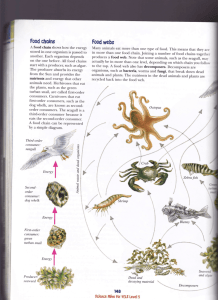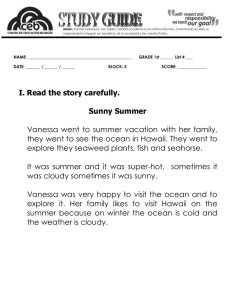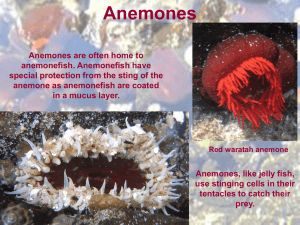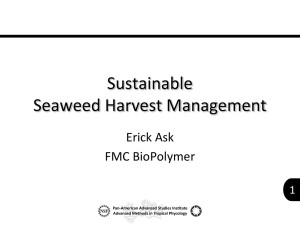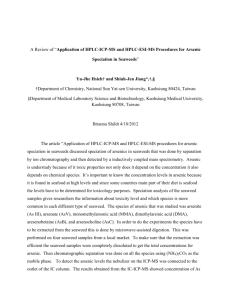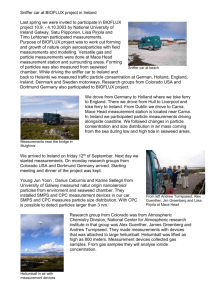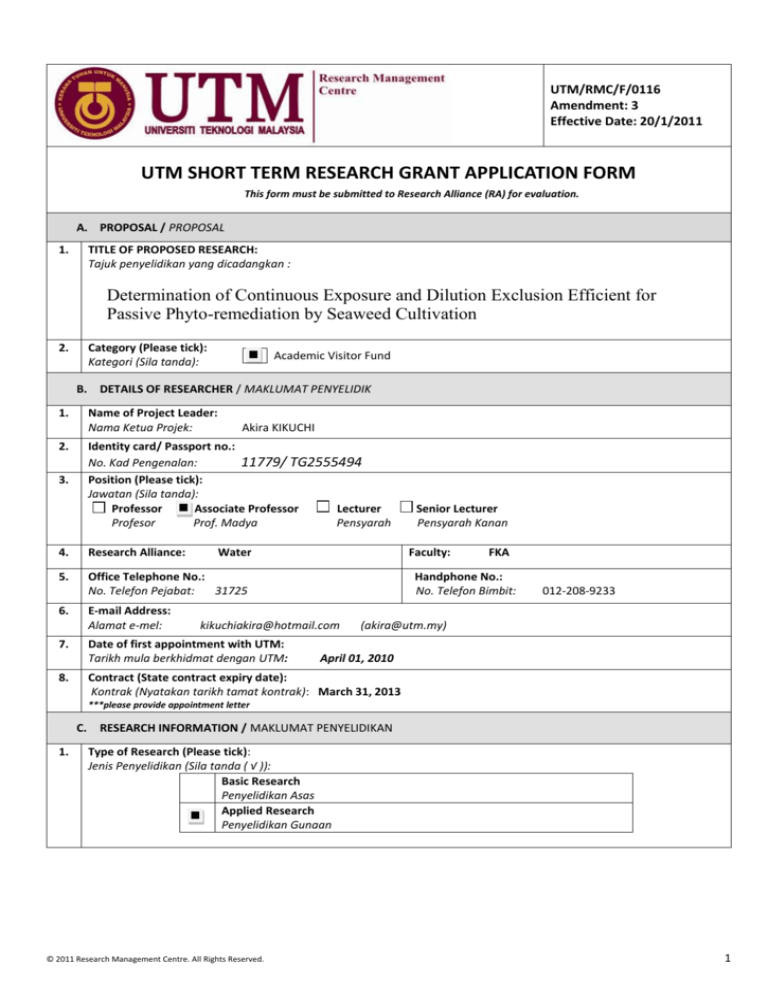
UTM/RMC/F/0116
Amendment: 3
Effective Date: 20/1/2011
UTM SHORT TERM RESEARCH GRANT APPLICATION FORM
This form must be submitted to Research Alliance (RA) for evaluation.
A. PROPOSAL / PROPOSAL
1.
TITLE OF PROPOSED RESEARCH:
Tajuk penyelidikan yang dicadangkan :
Determination of Continuous Exposure and Dilution Exclusion Efficient for
Passive Phyto-remediation by Seaweed Cultivation
2.
Category (Please tick):
Kategori (Sila tanda):
Academic Visitor Fund
B. DETAILS OF RESEARCHER / MAKLUMAT PENYELIDIK
1.
Name of Project Leader:
Nama Ketua Projek:
2.
Akira KIKUCHI
Identity card/ Passport no.:
No. Kad Pengenalan:
11779/ TG2555494
Position (Please tick):
Jawatan (Sila tanda):
Professor
Associate Professor
Lecturer
Profesor
Prof. Madya
Pensyarah
3.
4.
Research Alliance:
5.
Office Telephone No.:
No. Telefon Pejabat:
31725
6.
E-mail Address:
Alamat e-mel:
7.
Water
8.
Faculty:
FKA
Handphone No.:
No. Telefon Bimbit:
kikuchiakira@hotmail.com
Date of first appointment with UTM:
Tarikh mula berkhidmat dengan UTM:
Senior Lecturer
Pensyarah Kanan
012-208-9233
(akira@utm.my)
April 01, 2010
Contract (State contract expiry date):
Kontrak (Nyatakan tarikh tamat kontrak): March 31, 2013
***please provide appointment letter
C.
1.
RESEARCH INFORMATION / MAKLUMAT PENYELIDIKAN
Type of Research (Please tick):
Jenis Penyelidikan (Sila tanda ( √ )):
Basic Research
Penyelidikan Asas
Applied Research
Penyelidikan Gunaan
© 2011 Research Management Centre. All Rights Reserved.
1
2.
Research Area (Please tick):
Bidang Penyelidikan (Sila tanda ( √ )):
Pure Science
Sains Tulen
Applied Science
Sains Gunaan
Technology and Engineering
Teknologi dan Kejuruteraan
Medical Science
Sains Perubatan termasuk Penyelidikan Klinikal (Epidemiology)
Social Science and Humanities
Sains Sosial dan Kemanusiaan
Arts and Literature
Sastera dan Sastera Ikhtisas
Natural Sciences and National Heritage
(Geology, Archeology, Taxanomy, Ecology, Biodiversity)
3.
Fields of Research
(Please identify the main FOR Categories, FOR Groups and FOR areas, which most appropriately describe the scientific
discipline of your proposed project. Please select the FOR from the Malaysian Research and Development Classification,
5th Edition)
4.
5.
6.
FOR Category
Environmental Sciences
FOR Group
Environmental Management and Bioremediation
FOR Code & Area
Waste Bioremediation
SEO Categories being addressed by the project
(Please identify the SEO Category, SEO Group and SEO Area which most appropriately describe the main beneficiary of
your proposed project. The SEO Category is obtained under the SEO Division. Please select the SEO from the Malaysian
Research and Development Classification, 5th Edition)
SEO Category
Environment
SEO Group
Environment Aspect of Development
SEO Code & Area
Other Environmental Aspects of Development not
elswhere classified
Location of Research:
Tempat penyelidikan dijalankan:
Environmental laboratory, FKA, UTM
Duration of this research (Maximum 18 months):
Tempoh masa penyelidikan ini (Maksimum 18 bulan):
Duration: __1y_____
Tempoh :
From
Dari
7.
: ___ Apr. 1, 2011____
:
To
: __ Mar. 30, 2012___
Hingga :
Other Researchers (Please include your curriculum vitae):
Ahli-ahli penyelidik yang lain:
Bil
1
2
3
4
5
Name
Nama
Akira KIKUCHI
Mohad Ismid Mdsaid
Shamila Azman
Lavania Baloo
© 2011 Research Management Centre. All Rights Reserved.
IC No.
No. ID
TG 2555494
641029015215
73052907562
851123085506
RA/ Faculty
RA / Fakulti
Water/ FKA
Water/ FKA
Water/ FKA
FKA
Academic
Qualification/
Designation
Signature
PhD
PhD
PhD
M.Sc
2
International colloboration
This research is conducted as official international joint project between FKA&Water Research Alliance
and following organizations,
Japanese National Research Institute of Fisheries and Environment of Inland Sea, Fisheries Research
Agency (FEIS).
The Research Center for Coastal Lagoon Environments, Shimane University, Japan.
6
Usa Marine Biological Institute, Kochi University, Japan
Moreover, Japanese top level seaweed researchers will colloborate to develop our vision.
Dr. Masanori Hiraoka (Associate professor of Usa Marine Biological Institute, Kochi University,
Japan)
Dr. Motoharu Uchida, and Dr. Kenzo Yoseda (FEIS)
Mr. Shogo Arai (President, Seaweed Research Lab. Corporation, Japan)
8.
Research projects headed by the Applicant that have been completed or current ongoing in the last two years. Please
provide title of research, duration, year commence and year ending.
Sila sediakan maklumat termasuk termasuk tajuk, tempoh, tahun mula dan tahun tamat bagi penyelidikan yang
sedang/telah dijalankan oleh penyelidik-penyelidik di dalam tempoh tiga tahun terakhir.
Title of research including RMC vote number
Tajuk penyelidikan termasuk nombor vot RMC
9.
Duration
Tempoh
Beginning
month/year
Tarikh mula
bulan/tahun
Please furnish information on academic publications that has been published by the researchers for the last five (5)
years.( Example: Journals, Books, Chapters in books etc)
Sila kemukakan maklumat berkaitan penerbitan akademik yang telah diterbitkan oleh penyelidik dalam tempoh lima (5)
tahun terakhir. (Contoh: Jurnal, buku, bab dalam buku dll)
Title of publication
Tajuk penerbitan
Significance of the Easy-to-use
Water Quality Checker for
Participative Environmental
monitoring and Experience Based
Learning.
Ecological Open System
management for Human Impacted
Ecosystem.
Quantative Analysis of Landscape
Structure in Haji-Dam Watershed,
Hiroshima Prefecture.
High Resolution Stream Network
in Haji Dam Watershed.
Application of Asia Environment
Simulator (AES) to
Environmental Assessment in
Haji River Watershed.
Ion-exclusion/cation-exchange
chromatography for water quality
monitoring of river waters
© 2011 Research Management Centre. All Rights Reserved.
Name of journals/books
Nama jurnal/buku
Year published
Tahun diterbitkan
International Journal of Tropical Life
2010
Journal of International Development
and Cooperation
2009
Natural History of Nishi-Chugoku
Mountains
2008
Journal of International Development
and Cooperation
2007
Journal of International Development
and Cooperation
2007
Journal of Japan Industrial Water
Association
2007
3
Process of Phyllostachys
pubescens culm invasion at
Hikobia
expansion front.
Plant species response against
Journal of International Development
mowing in southwestern Japan.
and Cooperation
Others,
Three proceedings in International conferences
An invited speech in a international conference,
Two invited speeches in Foreign conferences.
Seven book chapters
Five governmental project reports.
10.
2006
2006
2006-2011
I hereby declare that:
Saya dengan ini mengaku bahawa:
All information stated here are accurate, UTM has right to reject or to cancel the offer without prior notice if
there is any inaccurate information given.
Semua maklumat yang diisi adalah benar, UTM berhak menolak permohonan atau membatalkan tawaran pada
bila-bila masa sekiranya keterangan yang dikemukakan adalah tidak benar.
Date :
Tarikh :
11.
Feb.
2011
Applicant’s Signature :
Tandatangan Pemohon : ___________________________
Executive Summary of Research Proposal (maximum 300 words)
(Please include the background of research, literature reviews, objectives, research methodology and expected
outcomes from the research project)
This research will be conducted to determine the effect of continuous exposure and dilution
exclusion efficient for passive phytoremediation system. Based on this research, a new-skill to
produce high quality seedlings will be developed through seedlings cultivation training. Then, the
skill will be applied for Malaysian seaweed species. This skill will enhance the ability to produce
seedlings for seaweed propagation. A numerical model to design phytoremediation system will be
constructed. From this model, extracted parameter from experiment will be assimilated on this
model. This algorithm will be applied to design and monitor laboratory-scale plant. Triplicate set
for each system is built and a comparative study between passive and batch system is observed.
Followed by, a significant test will be performed to measure the significance of the results between
the systems. Thereby, significant efficiency of passive phytoremediation system will be verified.
Optimization of passive system and batch phytoremediation system will be conducted by know-how
that is obtained above. Consequently, evidence of efficiency for batch and passive, and its combined
system will be determined. In conclusion, this research has significant importance which contributes
to innovation of seaweed culture by passive method and seedlings production techniques.
Moreover, this study also shows that seaweed biomass that is produced, could be used in many
applications, such as for food production, and environmental technologies.
12.
Detailed proposal of research project:
(a) Research background including Hypothesis /Research Questions and Literature Reviews.
a-1) General context
Macroalgae (seaweed) can be cultured effectively for the production of useful algal biomass which
has wide application to be processed into many by-products for human consumption and industrial
application. Some of the versatile products include food, soil conditioner, chemical and
pharmaceutical products (Troell et al. 1997; Capo et al. 1999). Besides that, the major industrial use
for seaweed is as a source of phycocolloids such as agar that mostly used as tissue culture media. The
increasing demand for hydrocolloid extracts during the past 40 years has led to dramatic growth of the
seaweed industry in few countries (Briggs and Smith 1993; Alveal et al. 1997).
© 2011 Research Management Centre. All Rights Reserved.
4
In Eastern Asian countries, particularly in Japan, China and Korea, seaweed cultivation has become
an integral part of daily diet(Bezerra & Marinho-Soriano 2010). The society is becoming aware of the
benefits and potential of macroalgae and new algal products. An imminent in novel uses of seaweeds
are acting as a stimulant to encourage more research and development of seaweed cultivation (Lüning
& Pang 2003). Thus, cultivation of seaweed has become a prominent industry where it generates
income for the country and improved the socio economics condition.
Besides the advantages discussed above, macroalgae also has been employed as an eco-friendly
treatment in reducing pollution load of wastewater and provides a natural biodiversity mechanism in
its environment. As a case study, (Fei 2004) conducted a study on coastal eutrophication problem in
China and successfully solved the problem by practicing large scale seaweed cultivation. His study
gives evidence that Gracilaria, Porphyra and Laminaria are the promising species for eutrophication
treatment in China. Troell et al. (1997) states that integrated culture of the rhodophyta Gracilaria
chilensis in salmon cages resulted in a substantial reduction of dissolved ammonium and phosphorus
released from the fish farm and subsequently reduces the risk of eutrophication.
A land based fish macroalgae integrated system was developed at Makoba Bay, Zanzibar, Tanzania
by Msuya et al. (2002). They have selected four species of macroalgae, planted them and measure its
efficiency as biofilters. Macroalgae Gracilaria crassa and Ulva reticula grew well with average
growth rates of 1.5% and 1.2%. Of the species tested, the macroalgae U. Reticula and G. Crassa are
superior biofilters in this type of integrated system. Seaweed has the potential to absorb excess
nutrient from the aquaculture excretory product whereby it acts as a water purification agent and
indirectly nutrients are incorporated into seaweed biomass.
a-2) Background of Study
According to Kaur and Ang (2009), seaweed cultivation has started from 1978 in Malaysia and it has
been successful in improving the livelihood of costal communities. However,after three decades has
past there are still only two species with commercial value. Eventhough Malaysia has suitable climate
to cultivate seaweed, the main market size as export only generated RM 44.5 milion in 2008. Based
on this fact, according to a report by Developing the Seaweed Aquaculture Sector in Malaysia (2009),
research required points are as shown in Table 1.
Table 1. Our direction in this research.
Required matter for seaweed
cultivation in Malaysia (Kaur & Ang 2009)
Point 1.
Capacity and capability of building in R&D
activity
Point 2.
Enhancing human resource at the technical
and nontechnical level
Point 3.
Discovering more ways to utilise seaweed
and its product
Point 4.
Exploration of new seaweed cultivation
method
Point 5.
Application of modern biology in high
quality seedling production
Point 6.
Expanding seaweed variety for production
Direction
To producea Ph.D student with top level skill
and networking with Japanese seaweed
researchers.
Excelent new-skill transfer from Japan, in
order to produce high quality seaweed
seedlings for wide species.
To test/invent new seaweed cultivation
method for environmental technology and
marketability.
From the six point listed, it is obvious that the first critical point should be adressed for human
resource, R&D capacity development by modern information. Accordingly, we are having our
approach 1) to produce a Ph.D student with top level skill and network between Japanese researchers. Then,
second critical point should be address for technical matter, such as, 2) how to produce vigorous high
quality seedlings without growth inhibitation and 3) its potential for wide variety of species.
It must be defined, Malaysian terittory has a great potential for seaweed cultivation (Kaur & Ang
2009), and seaweed-itself has great potential for food production, and wastewater treatment and
biomass resouce generation (Troell et al. 1997; Capo et al. 1999).The required solution is R&D
© 2011 Research Management Centre. All Rights Reserved.
5
development by Ph.D student generation via advanced research activity. Especially technical skills to
produce high quality seedlings are fundamentally important both research experiment and commercial
mass cultivation.
a-3) Research design and hypothesis
What we aimed is that macro algae with an existing high market value are highly susceptible to micro
algae when it grows under a continuous supply of excess nutrient, and strong light condition. Thus, to
load much nutrient is not efficient however, if excess nutrient cannot be consumed, macro algae do
not function as remediation agent. This paradox must be solved, when macro algae are applied to
phytoremediation agent as a value-added product.
Light energy
As a potential solution for this problem, we are
planning to investigate about passive system (Fig. 1).
Purified water
The main idea of this research is to transport excess
nutrient selectively to macro algae under shaded
condition, which restrain to provide nutrient to
microalgae under strong light condition. In the
Waste water
system, phytoremediation agent is settled between
waste water and purified water where wastewater
Fig. 1. Schematic depiction of passive system
continuously move throughout the seaweed bed. By
this system, very slowly moving wastewater
continuously exposed the seaweed, during this
a
process purified water is produced. Then light energy
b
is provided through purified water.
e
In this research, we are planning to investigate
Purified water
Light energy
about remediable system for wastewater treatment by
seaweed propagation (Fig. 2). In our system, seaweed Waste water
d
(a) functions as a kind of enzyme from a sense of
Seaweed
resource
Hyper cycle (Eigen & Schuster 1978). Thereby
c
excess nutrient in wastewater (b) is purified by
Fig. 2. Schematic depiction of passive system
seaweed propagation (c), then grown portion of
seaweed is cropped (d) and water discharge after purified.
From the concept of entropy, the wastewater has high entropy status (e.g. non-useful). In contrast,
purified water and cropped seaweed have lower entropy (e.g. useful). The phytoremediation layer,
which contacted these two high and low entropy spaces, pump up the energy status (or minimize the
entropy) of environment by light energy. Our system is a pump to generate environmental resource
from waste by natural energy. This is the scientific firm definition of “remediation” in this study.
Accordingly, a comparative study is proposed to determine the efficiency of the new system, in
between passive and conventional batch method for the same phytobioremediation agent. Hereby, our
research hyporthesis for whole research level is as follows,
Hypothesis:
A phytoremediation system, passive method (Fig 5) has better efficiency than conventional
batch method (Fig. 6).
Reference>
Alveal, K., H. Romo, et al. (1997). "Mass cultivation of the agar-producing alga Gracilaria chilensis
(Rhodophyta) from spores." Aquaculture 148(2-3): 77-83.
Bezerra, A. F. and E. Marinho-Soriano (2010). "Cultivation of the red seaweed Gracilaria birdiae
(Gracilariales, Rhodophyta) in tropical waters of northeast Brazil." Biomass and Bioenergy 34(12): 18131817.
Briggs, M. R. P. and S. J. F.-. Smith (1993). Macroalgae in Aquaculture: An Overview and their Possible Role
in Shrimp Culture. Marine Biotechnology. Bangkok, Thailand: 11.
Capo, T., J. Jaramillo, et al. (1999). "Sustained high yields of Gracilaria (Rhodophyta) grown in intensive
large-scale culture." Journal of Applied Phycology 11(2): 143-147.
Eigen, M. & Schuster, P. (1978) Part A: Emergence of the Hypercycle.” Naturwissenschaften 65:7–41.
Fei, X. (2004). "Solving the coastal eutrophication problem by large scale seaweed cultivation." Hydrobiologia
© 2011 Research Management Centre. All Rights Reserved.
6
512(1): 145-151.
Kaur, C.R. & Ang, M. (2009) Seminar report. Developing the seaweed aquaculture sector in Malaysia.
Lüning, K. and S. Pang (2003). "Mass cultivation of seaweeds: current aspects and approaches." Journal of
Applied Phycology 15(2): 115-119.
Msuya, F. E., M. S. Kyewalyanga, et al. (2006). "The performance of the seaweed Ulva reticulata as a biofilter
in a low-tech, low-cost, gravity generated water flow regime in Zanzibar, Tanzania." Aquaculture 254(1-4):
284-292.
Troell, M., C. Halling, et al. (1997). "Integrated marine cultivation of Gracilaria chilensis (Gracilariales,
Rhodophyta) and salmon cages for reduced environmental impact and increased economic output."
Aquaculture 156(1-2): 45-61.
(b) Objective (s) of the Research
i.
To design seawead cultivation system for experimental plant by numerical model construction
and parameter assimilations.
ii.
To conduct comparative study between passive and batch phytoremediation system in order to
measure the efficiency and significance of both system.
iii.
To carry-out optimization process of integration for both system via parameters abstraction
and assimilation to numerical models.
© 2011 Research Management Centre. All Rights Reserved.
7
(c) Methodology
Kaedah penyelidikan
Please state in the form / Sila nyatakan di borang ini
1.Description of Methodology
In this study, four actual research topics will be investigated. As shown in research design matrix
(Appendix 2). High quality seedling production, and numerical model development are fundamental
part of this research. Then the efficiency test of passive phytoremidiation study,which is conducted as
comparative study, has firm academic originality. On top of these evidence, generalized experiment
will be conducted as assessment of efficiency for passive and batch system in order to produce papers
and a patent.
New skill to produce high quality seedlings
We transfer Dr. Hiraoka’s bio-technology, which is
whart
one of the most excellent technique to make high
sea
quality seedlings to generate biomass resource. By
this techniques, dense, fast-growing, high quality
seaweed cultivation can be realized for almost all
macroalgae. Mass production of seedlings are also
Bio -technology
seaweed (same species)
easy to perform. This technique is not only proven as
scientific publication, but also he is honoured by this
technology in a national venture buisiness planning
Thin-tender thallus seaweed
Star-shape seaweed floating
growing on sea whart.
in a cultivation tank.
competition. This technology is already applied for
commercial mass seaweed cultivation by his
Fig. 3. Dr. Hiraoka’s bio-technology.
company, which indicate this biotechnology is very
important for both research and development. In this research, a PhD course student get skil and
training for this technology via attachment program, several species of tender thallus (leaf-shape)
algae will be selected to produce seedlings for our experiment.
Total amount of biomass
Numerical model to design phyto-remediation system
It can be assumed the efficiency of the excess
nutrient removal is considerd from yield of the
Carrying capacity (K)
phytoremediation agent. In this research, sea
algae is used for phytremediation agent in order
absorb excess nutrient. As a natural
consequence from the assumption, the uptaken
MSY
Internal growth rate (r)
nutrient is monitored by propagated biomass. Of
course N and C concentration of seaweed tissue
also analized as a critical parameter. Hereby, if
Time (t)
theoretically, the maximum sustainable yield
Fig.
4.
A
numerical
model
to
design
phyto-remediational
system
(MSY) is considered, which is the most
optimized function of phyto-remediational agent by the system. This point should be defined as the
first desidaratum to develop bioremediation system.
MSY is, the largest yield that can be continiously taken from a stocked biomass-resouce over an
indefinite period. Fundamental to the notion of sustainable harvest, the concept of MSY aims to
maintain the total amout of biomass at the point of maximum growth rate by harvesting a part of the
stocked biomass. It would normally be surplus of stocked biomass, which allowing to keep maximum
productivity indefinitely.
Logistic growth model is applied, where reprocuction rate is assumed as intrinsic for each species.
Then if the stocked biomass are small, but because there are few biomass, the overall yield is small.
On the contrary, the stocked biomass increasingly limit breeding until the population reaches carrying
capacity. At this point, there are no surplus individuals to be harvested and yield drops to zero. Here,
at intermediate stocked biomass is performed, represented by half of the carrying capacity, the stocked
biomas are able to propagate performing their maximum growing rate. At this point, called the MSY,
there is a surplus stocked biomass that can be harvested because growth of the population is at its
maximum point due to the large ability of reproducing.
In this research, a numerical model will be formularized basing a logistic growing curve by critical
parameter of K and r (refer figure), which assimilated with controlling parameter of experimental
passive and batch phytoremediation system. In reality, a theory that realize better economic
management process to manage MSY i.e. MEY (maximum economic yield) will be investigated for
experimental test plants. Multiparameter approach for system optimization may be applied.
© 2011 Research Management Centre. All Rights Reserved.
8
Comparative study between passive and batch systems
Triplicated passive system and conventional batch seaweed cultivation system will be developed,
respectively. The systems will be designed as terrestrial system. Then the efficiency of the excess
nutrient removal is assessed by increased biomass of phytoremediation agent (seaweed). Every week,
the biomass growth rate of cultivated seaweed will be monitored in fresh weight. During the
experimental period, the condition, such as, pH, temperature, light intensity, salinity, and nutrient
loading will be managed as same level between two systems. Exchange rate of water is 5 times daily.
On the other hand, water quality such as NH4+, NO2-, NO3-, and PO43-, DO, pH, salinity, conductivity,
and temperature are also monitored. Then, the significance test for efficiency to uptake each water
quality parameter will be assessed for one (1) species, such as thin-tender thallus seaweed (e.g.
Gracilaria edulis). The collected data will be analyzed via Bayesian statistics, to evaluate how much
the difference is significant.
Both passive and batch system are designed, as follows,
Passive system
The main part of the system is passive
2
bioremediational component (1). Excess nutrient is
provided from reservoir (2), flowing through the
4
bioremediational component. Between reservoir and
1
bioremediational component, a particular component
for duration and sand filtration component may be
installed. After the material passed the
bioremediational part, it is discharged (4). Excess
3
nutrients are absorbed by bioremediational component
as biological resources. Regarding a patent
generation, boundary condition of passive system is
being explained by four points as follows,
Structure requirement
Fig. 5. Passive phyto-remediation system.
As long as a system functions is passive feature, it is
overlooked about the feature of phytoremediation part, e.g. submerged open space, transparent
column reactor, and etc. Here, passive means that water is provided as transparent flow through
bioremediational component. Thereby, if this feature is confirmed, material can be provided
through sea/lake/river bottom. Gravity driven groundwater flow also possible to apply for phytoremediation by seaweed/seagrass bed in a restoration act in a field.
Bioremediation part
Any livelihood can be used for bioremediational part, such as algal bed, sea grass bed, diatom
films, and so on.
Provided material
It is overlooked the any material, such as, eutrophic water, waste effluent, and any other polluted
and unpolluted material can be applied for remediation.
Pretreatment
It may be inevitable component between reservoir (2) and bioremediton part (1) that treat resource
material purify/treat before it provided to bioremediation livings. Such a component will be
important when food resources will be formed.
Batch system
This type of system is able to define a conventional
method to cultivate seaweed. Bubbling circulative
batch method may have an advantage to provide
enough light energy for all the floating thallus algae.
The main component of the system is cultivation
tank. The sea water inside is circulating by bubbling
(1). The excess nutrient is provided from reservoir
(2), by gravity flow. Then the provided water is
mixed and diluted then, consumed by floating
macro algae. Water discharged from the cultivation
tank (4). The excess nutrient are diluted then
consumed by seaweed, accordingly, the efficiency
of absorption may not better than passive method.
2
4
1
3
Fig. 6. Batch type phyto-remediation system.
© 2011 Research Management Centre. All Rights Reserved.
9
To optimize the efficiency of passive system and batch system
We are assuming that our hypothesis, such as significance of passive system, will be accepted as a
result from this study. On top of this assumption, we have few plans for optimization processes.
Passive system
Using dendritic tough seaweed (e.g. Graciralia edulis), airtificial seaweed bed will be designed as
phytoremediation component. Then the efficiency will be tested for excess nutrient control for waste
water. System parameters, such as
*The thickness and density of seaweed bed.
*Nutrient loading capacity for MEY(mean economic yield).
will be optimized in order to enlarge K and r (see Fig. 4) using the outcome results. Three passive
system will be applied for this research. The target parameter is settled on nitrogen (nitrate, nitrite, and
amonium). Fresh weight and water quality will be monitored every week. Other environmental
parameters, such as pH, water temperature, salinity, light intensity also will be monitored to explain
base line.
Batch system
Using tender thallus (leaf-shape) seaweed will be converted to star shape feature by outcome of topic
1. Strong light prone species will be chosen for this experiment. The system parameters, such as
*The density of star-shape seaweed floating.
*Nutrient loading capacity for MEY(mean economic yield).
will be optimized by outcome. Three experimental test plant will be used for this optimization
process. The target parameter is settled on nitrogen (nitrate, nitrite, and amonium). Fresh weight and
water quality will be monitored every week. Other environmental parameters, such as pH, water
temperature, salinity, light intensity also will be monitored to explain base line.
Combined system
After passive sytem and batch system are optimized, one experimental plant will be investigated.
Because, even if passive system will perform high efficiency of waste water purification, some excess
nutrient will be pass through. Accordingly, there are still possibility to apply batch system after the
batch system, as a kind of mix cultivation system. The structure of this system is shown in Fig. 7. As
for this sytem, because the batch system purify waste water, the efficiency of phyto-remediation will
be increased, however the algal bed for passive system will be shaded by floating star-shape seaweed,
so that the efficiency of passive system will be decrease. Here, what we test here is the synergy effect
between Passive and batch system. According to
3
ecological sense, the total efficiency will increase.
One (1) experimental test plant will be
composed. Dendritic tough seaweed (e.g.
4
Graciralia edulis) will be used for passive
bioremediational agent (1), and storong right prone
seawee for batch bioremediational agent (3).
2
Excess nutrient is provided from reservoir (2), then
same amount of water discharge (4) after excess
nutrient absolved by seaweed. The same procedure
take above will be applied,then the efficiency of
this system will be optimized for MEYfor both
1
phyto-remediational agents. The target parameter is
settled on nitrogen (nitrate, nitrite, and anmonium).
Other environmental parameter, such as pH, water
temperature, salinity, light intensity will be
monitored to explain base line.
Fig. 7. Combined system
2.Flow Chart of Research Activities ( Please enclose in the Appendix)
Appendix A.
3.Gantt Chart of Research Activities (Please enclose in the Appendix)
Appendix B.
4. Milestones and Dates
Appendix B.
© 2011 Research Management Centre. All Rights Reserved.
10
(d) Expected Results/Benefit
Jangkaan Hasil Penyelidikan
1. Critical Mass (PI) University Funded.
At least one (1) doctoral course student will complete her study by this research. Moreover the student
will get skilled as a principle researcher. All collaborators will overall support this matter.
2. Award.
The passive method bioremediation system has unique for environmental technology. Accordingly,
the contribution is considered as competitive in domestic and international level too. The result of this
project will participate in both local and international competitions.
3. Publication
Three (2) papers accepted in the duration time (flow chart: Appendix A.).
4. Number Post Graduate enrolled.
One (1) doctoral student from 4th to 6th semester.
5. IPR
One (1) patent will be developed for passive phyto-remediation system (Appendix A).
6. Membership in International bodies/ association.
Not required.
7. Membership in International Profesional Bodies.
Not required.
8. Membership in Profesional Bodies / Associations.
Not required.
D. ACCESS TO EQUIPMENT AND MATERIAL / KEMUDAHAN SEDIA ADA UNTUK KEGUNAAN BAGI PENYELIDIKAN INI
University
Universiti
Other Sources or Places
Lain-lain tempat/sumber
Example / Contoh:
Equipments:
Light microscope
Stirrer
Autoclave
HACH Spectrophotometer
Shaker
Illuminator detector
Total Organic Carbon (TOC) analyzer
Incubator
Analytical weight
Water checker probe (DO, pH, salinity and conductivity)
Scanning electron microscope (SEM)
© 2011 Research Management Centre. All Rights Reserved.
UTM
UTM
UTM
UTM
UTM
UTM
UTM
UTM
UTM
UTM
UTM
UTM
11
E.
BUDGET /BELANJAWAN
Please indicate your estimated budget for this research and details of expenditure according to the guidelines
attached.
Sila nyatakan anggaran bajet bagi cadangan penyelidikan ini dan berikan butir – butir perbelanjaan lengkap dengan
berpandukan kepada garis panduan yang dilampirkan.
Budget details
Butiran belanjawan
Amount requested by applicant
Jumlah yang dipohon
oleh pemohon
Year 1
Tahun 1
(RM)
1.
2.
Vote 11000 Salary and wages
Gaji dan upah
Example/contoh:
Upah Graduate Research
Assistant (GRA).
1 PhD student, under
scholarship
Year 2
Tahun 2
(RM)
Total
Jumlah
(RM)
-
-
Nil
18000
-
18000
Amount recommended
by Executive Director of
Research Alliance
Jumlah yang diperakukan
oleh Pengarah Eksekutif
Research Alliance
Amount
approved by
Director of
RMC
Jumlah yang
diluluskan oleh
Pengarah RMC
Please Indicate the
overall Budget
Sila nyatakan bajet
secara keseluruhan
To be filled by
RMC
Vote 21000 Travelling
Expenses and
Subsistence/
Conference (2 times;
international and national)
*Researcher& PhD student
Daily allowance+Travelling+
Lodging
= (RM150 + RM200 +
RM300) x 2 times
= RM1,300
Workshop (1 time,
national) and Seminar (1
time, Kuala Lumpur)
Details:
*Researcher & PhD
student
Daily allowance+Travelling+
Lodging
= (RM150 + RM200 +
RM150) x 1 time
= RM500
Sampling and data
collection (travelling to
sampling site): (2 times/
month)
Details:
*Researcher & PhD student
= RM50 x 2 times x
12months
= RM 1200
© 2011 Research Management Centre. All Rights Reserved.
12
Technical visit to Kochi
University, and Japanese
national institute of
fisheries and environment
of Inland sea, fisheries
research agency, Japan ( 2
persons, 1 time)
Details:
*PhD student (3 months)
Allowance+Travelling
+ Lodging
= RM8000+
RM5000+RM2000
= RM15,000
3.
Vote 24000 Rental
4.
Vote 26000 –
Supply of Raw Materials &
Materials for Repair and
Maintenance
Nil
Nil
Nil
12,000
-
12,000
-HACH reagents for water
quality analysis, such as
Nitrate, Nitrite, Ammoniacal
nitrogen, COD, BOD,TN,
TP and standard solutions.
Consumables (Disposable
materials such as
silicon tubing, pipette tips,
membrane, gloves,air pump,
cultivation tank, valve, PVC
tube, Net,and T4 light)
5.
Vote 28000 Maintenance and Minor
Repair Services
-
-
NIL
6.
Vote 29000 Professional Services and
other services Including
printing & hoispitality,
Honorarium for subjects.
-
-
NIL
7.
Vote 35000 Equipment
Peralatan
-
-
NIL
30,000
-
30,000
TOTAL AMOUNT
JUMLAH BESAR
© 2011 Research Management Centre. All Rights Reserved.
13
F.
RECOMMENDATION BY EXECUTIVE DIRECTOR (RESEARCH ALLIANCE) / PERAKUAN PENGARAH EKSEKUTIF (RESEARCH
ALLIANCE)
Recommendation (Please tick √ ) :
Diperakukan (Sila tandakan √ ) :
A.
Highly Recommended
Sangat Disokong
B.
Recommended
Disokong
C.
Not Recommended (Please specify reason)
Tidak Disokong (Sila Nyatakan Sebab)
General Comments:
Ulasan umum:
------------------------------------------------------------------------------------------------------------------------------------------------------------------------------------------------------------------------------------------------------------------------------------------------------------------------------------------------------------------------------------------------------------------------------------------------------------------------------------------------------------------------Name:
Signature:
Nama:
Tandatangan:
Date:
Tarikh:
G. APPROVAL BY DEPUTY VICE CHANCELLOR (RESEARCH AND INNOVATION)/DIRECTOR RESEARCH MANAGEMENT
CENTRE / KELULUSAN TIMBALAN NAIB CANSELOR(P & I )/ PENGARAH PUSAT PENGURUSAN PENYELIDIKAN
Recommendation (Please tick √) :
Diperakukan (Sila tandakan √ ):
A.
Approved
Diluluskan
B.
Rejected (Please specify reason)
Ditolak (Sila Nyatakan Sebab)
General Comments:
Ulasan umum:
------------------------------------------------------------------------------------------------------------------------------------------------------------------------------------------------------------------------------------------------------------------------------------------------------------------------------------------------------------------------------------------------------------------------------------------------------------------------------------------------------------------------Name:
Signature:
Nama:
Tandatangan:
Date:
Tarikh:
© 2011 Research Management Centre. All Rights Reserved.
14
Appendix A.
Determination of Continuous Exposure and Dilution Exclusion Efficient
for Passive Phyto-remediation
Topic 1
Topic 2
Topic 3
New-skill transfer to
produce high quality
seedlings
A numerical model to
design phytoremediation system
Comparative study
between passive and
batch systems
Seaweed cultivation
training
Numerical model
construction
Comparative
experiment
Application for
Malaysian species
Data analysis
and modeling
Significant
analysis
No
Yes
No
Yes
Able to produce
seedlings for
seaweed propagation.
An algorithm to design
and optimize bioremediational plant by
seaweed propagation.
one (1) impact factor
publication
No
Yes
Significant efficiency of
both system for diffrent
type of seaweed.
one (1) impact factor
publication
,and one(1) patent
Topic 4
System optimization by know how from topic 1, 2, and 3.
(b)
(c)
A floating
A passive-batch
batch system
combined system
by tender thallus
by two seaweeds
Seaweed
one (1) publication
one (1) publication
one (1)
submitted
submitted
publication
submitted
(a)
A passive system
by dendritic
tough seaweed
Evidence of efficiency for (a)passive, (b)batch,
and its integrated system.
Expected recommendation after this research,
•Inovative research on seaweed science producing Ph.D student.
•To produce high quality seedlings for various kind of seaweed research in Malaysia.
•Application of this study for food production, and environmental technologies.
© 2011 Research Management Centre. All Rights Reserved.
15
Appendix B
2011
No
Project Activities
1
Literature review
3
Numerical model construction
4
5
6
7
2012
8
9
10
11
12
1
2
New skill transfer to
seedlings
produce
high
5
Seadrings production by Malaysian species
quality
4
6
8
9
1
2
3
4
Attending workshop / seminar / conference
Seaweed cultiation training (to learn seedlings
production skill in Kochi University, Japan, and
Japanese National Research Institute of Fisheries
and Environment of Inland Sea, Fisheries
Research Agency)
Milestone (May 2011) - Numerical model produced.
Milestone (Oct 2011) - Competency in seedlings cultivation by advanced technology.
Milestone (Jun. 2012) - Establish comparison between batch and passive phyto-remediation system, and optimization.
Milestone (Mar 2012) - Report submission.
16
Report Writing and publication
11 Research Management Centre. All Rights Reserved.
7
Comparative study in between Passive and Batch
system. (2condition 3 reprication)
System optimization for batch, passive, and
combined system (2condition 3 reprication, plus
1combine system)
3
2
Attachment 1. Research design matrix
Higher
objective
Determination of Continuous Exposure and Dilution Exclusion Efficient for Passive
Phyto-remediation
Topic ID
Actual
objectives
[1]
New-skill to
produce high
(Investigations) quality seedlings
Methodology
Expected
result
Indicator/
outcome
Expected
recommendation
11 Research Management Centre. All Rights Reserved.
[2]
Numerical model to
design phytoremediation system
Attachment program, Numerical model
and its application for construction, and
Malaysian species
parameter assimilations
Abilities to produce
An algorithm to design
seedlings for
and monitor phytoseawead propagation. remediational plant by
seaweed propagation.
Competency to
One (1) paper accepted
provide seedring for
experiment.
[3]
Comparative study
between passive and
batch systems
[4]
Optimization of passive
system and batch
phyto-remediation
system
Comparative
System optimization by
experiment, and
know-how from [1], [2],
significant test
[3].
Significant efficiency of Evidence of efficiency
both system for diffrent for batch and passive,
type of seaweed.
and its combined system
will be determined.
One(1) impact factor
One(1) impact factor
publication accepted,
publication accepted.
and one(1) patent.
Basing on these researches,
• Inovative researches on seaweed research with generated Ph.D student.
•To produce high quality seedlings for many kind of seaweed researches in Malaysia.
•Application of this studies for food prduction, and environmental technologies.
17
February 24, 2011
To,
Prof. Dr. Zulkifli Yusoff
Water Research Alliance, Universiti Teknologi Malaysia
Skudai, 81310, Johor, Malaysia. tel. +607-55-31725
I would like to submit this proposal for Academic Visitor Fund, which is so called initial
grant for international contract stuff. I already discuss the both applicability about this
grant and GUP with RMC officer who in charge this matter on 22 Feb, 2011. I would like
ask to perform three points by this matter as Water Research Alliance, as follows,
1. One of the aims of this study is to send a doctoral student to Japan for research
training. Accordingly, the cost for research assistant is not estimated (p12). Please
kindly approve this point.
2. On the contrary, in order to perform this matter, budget for technical visit to Japanese
University and Research Institute for three month is estimated as RM 15,000.
Accordingly, the category travelling Expenses and Subsistence is 60%. This technical
training is inevitable for the doctoral student and this research too, so that please
kindly approve this estimation.
3. I know it is not gentle to say such a matter; however unfortunately from my
inconvenient experience, if technically you will not chose Dr. Fadil as reviewer for
this research proposal, I am very appreciate.
Dr. Akira KIKUCHI
Institute of environmental and water resource Management (IPASA),
Universiti Teknologi Malaysia
81310, Skudai Johor, Malaysia
© 2011 Research Management Centre. All Rights Reserved.
18


